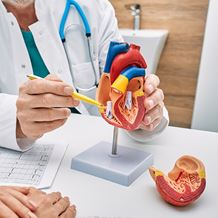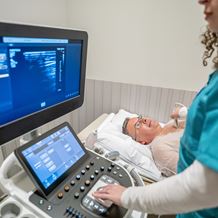
- Home
- Services
- Cardiac Services
- Conditions
- Spontaneous Coronary Artery Dissection (SCAD)
What is Spontaneous Coronary Artery Dissection (SCAD)?
Spontaneous coronary artery dissection (SCAD) is an emergency condition that occurs when part of the artery wall suddenly separates or tears without warning. When the artery lining tears, blood is able to seep and collect in the areas in between the inner and outer layers. This reduces the blood flow through the important coronary artery, and potentially blocks it completely. If the heart is not getting the right amount of blood, it can lead to life-threatening conditions such as heart failure or a heart attack. SCAD is generally considered a rare heart condition that most commonly affects women in their 40s and 50s, although it can also affect men. When SCAD occurs, immediate medical attention is necessary.
Symptoms and causes
SCAD cannot be predicted and often occurs in patients that do not have the usual risk factors associated with heart disease. This means it is easy to misdiagnose. The exact cause remains unclear, but common trigger factors include post-menopausal women or women who have recently given birth, intense exercise, or emotional stress. Certain medical conditions such as particular inflammatory diseases and high blood pressure carry an increased risk of SCAD. The symptoms can closely resemble those of a heart attack and may include:
- Chest pain or pressure
- Shortness of breath
- Excessive sweating
- Nausea, vomiting or indigestion
- Dizziness
- Rapid heartbeat or fluttering
- Pain in the jaw, arm or shoulder
- Fatigue
How is it diagnosed?
The tests to diagnose SCAD aim to measure the activity in your heart and locate the size of the tear. The condition is usually diagnosed through testing that is similar to that of a heart attack, and typically includes:
- ECG (electrocardiogram) – to measure the electrical activity in your heart
- Blood tests – to check for markers that indicate a heart attack
- Coronary angiogram – to check for the location of the tear and any blockage
How is it treated?
Any SCAD treatment will vary by patient as it will depend upon the size and location of the tear, and the amount of damage to your heart. The primary aim of treatment is to restore blood flow to the heart. In milder cases, the arterial tear can be safely left to heal naturally. Medication can also be used to prevent blood clots, reduce the blood pressure and manage any painful symptoms. In more severe SCAD cases, your doctor may recommend surgery to repair the damage caused by the tear and to manage any potential risk of further problems. This may include inserting a stent to improve the blood flow, or coronary bypass surgery.

Other conditions
What's next?
If you have been experiencing heart-related symptoms, book an appointment with our cardiac services specialist today.
Our specialists in Cardiac Services
View all specialists




